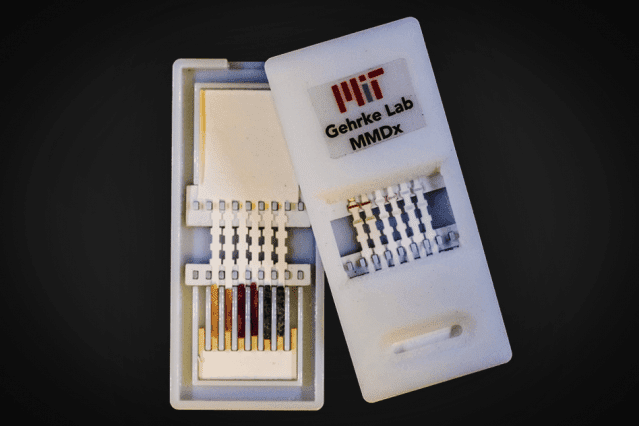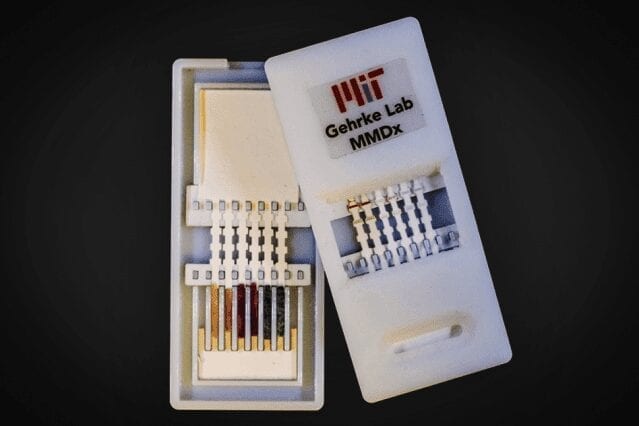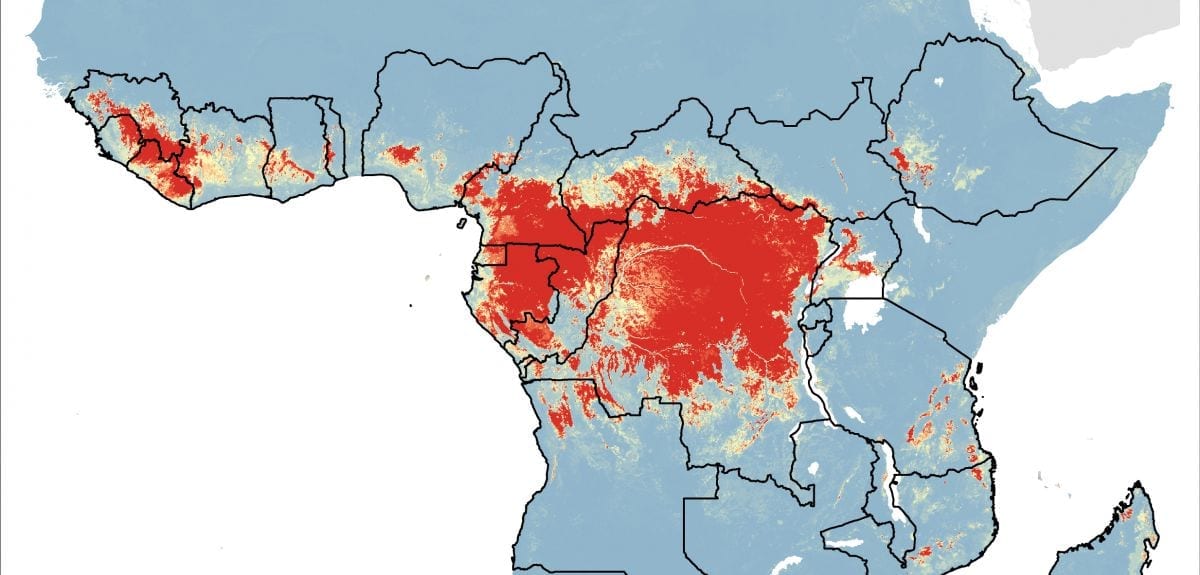
Photo courtesy of Jose Gomez-Marquez, Helena de Puig, and Chun-Wan Yen
When diagnosing a case of Ebola, time is of the essence. However, existing diagnostic tests take at least a day or two to yield results, preventing health care workers from quickly determining whether a patient needs immediate treatment and isolation.
A new test from MIT researchers could change that: The device, a simple paper strip similar to a pregnancy test, can rapidly diagnose Ebola, as well as other viral hemorrhagic fevers such as yellow fever and dengue fever.
“As we saw with the recent Ebola outbreak, sometimes people present with symptoms and it’s not clear what they have,” says Kimberly Hamad-Schifferli, a visiting scientist in MIT’s Department of Mechanical Engineering and a member of the technical staff at MIT’s Lincoln Laboratory. “We wanted to come up with a rapid diagnostic that could differentiate between different diseases.”
Hamad-Schifferli and Lee Gehrke, the Hermann L.F. von Helmholtz Professor in MIT’s Institute for Medical Engineering and Science (IMES), are the senior authors of a paper describing the new device in the journal Lab on a Chip. The paper’s lead author is IMES postdoc Chun-Wan Yen, and other authors are graduate student Helena de Puig, IMES postdoc Justina Tam, IMES instructor Jose Gomez-Marquez, and visiting scientist Irene Bosch.
Color-coded test
Currently, the only way to diagnose Ebola is to send patient blood samples to a lab that can perform advanced techniques such as polymerase chain reaction (PCR), which can detect genetic material from the Ebola virus. This is very accurate but time-consuming, and some areas of Africa where Ebola and other fevers are endemic have limited access to this kind of technology.
The new device relies on lateral flow technology, which is used in pregnancy tests and has recently been exploited for diagnosing strep throat and other bacterial infections. Until now, however, no one has applied a multiplexing approach, using multicolored nanoparticles, to simultaneously screen for multiple pathogens.
“For many hemorrhagic fever viruses, like West Nile and dengue and Ebola, and a lot of other ones in developing countries, like Argentine hemorrhagic fever and the Hantavirus diseases, there are just no rapid diagnostics at all,” says Gehrke, who began working with Hamad-Schifferli four years ago to develop the new device.
Unlike most existing paper diagnostics, which test for only one disease, the new MIT strips are color-coded so they can be used to distinguish among several diseases. To achieve that, the researchers used triangular nanoparticles, made of silver, that can take on different colors depending on their size.
The researchers created red, orange, and green nanoparticles and linked them to antibodies that recognize Ebola, dengue fever, and yellow fever. As a patient’s blood serum flows along the strip, any viral proteins that match the antibodies painted on the stripes will get caught, and those nanoparticles will become visible. This can be seen by the naked eye; for those who are colorblind, a cellphone camera could be used to distinguish the colors.
“When we run a patient sample through the strip, if you see an orange band you know they have yellow fever, if it shows up as a red band you know they have Ebola, and if it shows up green then we know that they have dengue,” Hamad-Schifferli says.
This process takes about 10 minutes, allowing health care workers to rapidly perform triage and determine if patients should be isolated, helping to prevent the disease from spreading further.
Read more: Simple paper strip can diagnose Ebola and other fevers within 10 minutes
The Latest on: Ebola Diagnosis
[google_news title=”” keyword=”Ebola Diagnosis” num_posts=”10″ blurb_length=”0″ show_thumb=”left”]
via Google News
The Latest on: Ebola Diagnosis
- Will AI replace doctors?on May 7, 2024 at 9:06 pm
Yes, weather prediction has been immensely improved by computer and AI use, but there we are dealing with physics. If air speed, humidity and heat are in a certain range, computers could easily ...
- Making their MARC: Yajahira Dircioon April 10, 2024 at 5:00 pm
Dircio is working on developing a rapid test prototype for Ebola diagnosis. “The sooner you get treatment, the better the patient outcome is,” Dircio said. The team injects mice with the virus-like ...
- Lessons learned from Ebola.on March 26, 2024 at 7:36 am
Overview: This practice briefing sets out what BBC Media Action learned in delivering and supporting health communication in response to the Ebola crisis in West Africa in 2014–15. It has a ...
- CONTENT MEDICALLY REVIEWED BYon March 12, 2024 at 8:31 am
Diagnosis of Ebola virus infection involves enquiring travel and work history, and exposure to wildlife. Blood tests are performed to detect viral particles (PCR test), or to measure immune ...
- Ebola viruson November 9, 2022 at 4:00 pm
Kadiatou and Ibrahima, Ebola orphans from Guinea, share their experience of stigma and loss ten years since the outbreak. Some Ugandans have been attacking the government's efforts, even denying ...
- Marburg, Monkeypox, And Other Viruses Emerging From Africaon July 17, 2022 at 9:16 am
Samples were sent to the Institut Pasteur in Senegal for confirmation, which has just confirmed the diagnosis ... that cause hemorrhagic fevers, like Ebola and Marburg. Monkeypox, anthrax ...
- Spillover — Zika, Ebola & Beyondon October 16, 2020 at 10:44 am
Join scientists as they investigate the rise of spillover viruses like Zika, Ebola and Coronavirus, and learn what science can do to anticipate and prevent epidemics around the world.
- Seeking the Source of Ebolaon January 6, 2019 at 3:30 am
This was almost three months before the word “Ebola” began to flicker luridly in email traffic between Guinea and the wider world. The public health authorities based in Guinea’s capital ...
- Topic: Irwin Redleneron June 30, 2017 at 9:54 pm
Health officials to New Yorkers: stay calm as steps are taken to keep city safe from Ebola Officials are urging New Yorkers to stay calm as authorities take steps to ensure Craig Spencer's Ebola ...
- Ebola viruson December 2, 2014 at 3:24 am
The on-going Ebola outbreak in the West African countries is so far the worst in the history of the deadly disease. The virus seems to have gripped the world's interest due to its destructive ...
via Bing News











